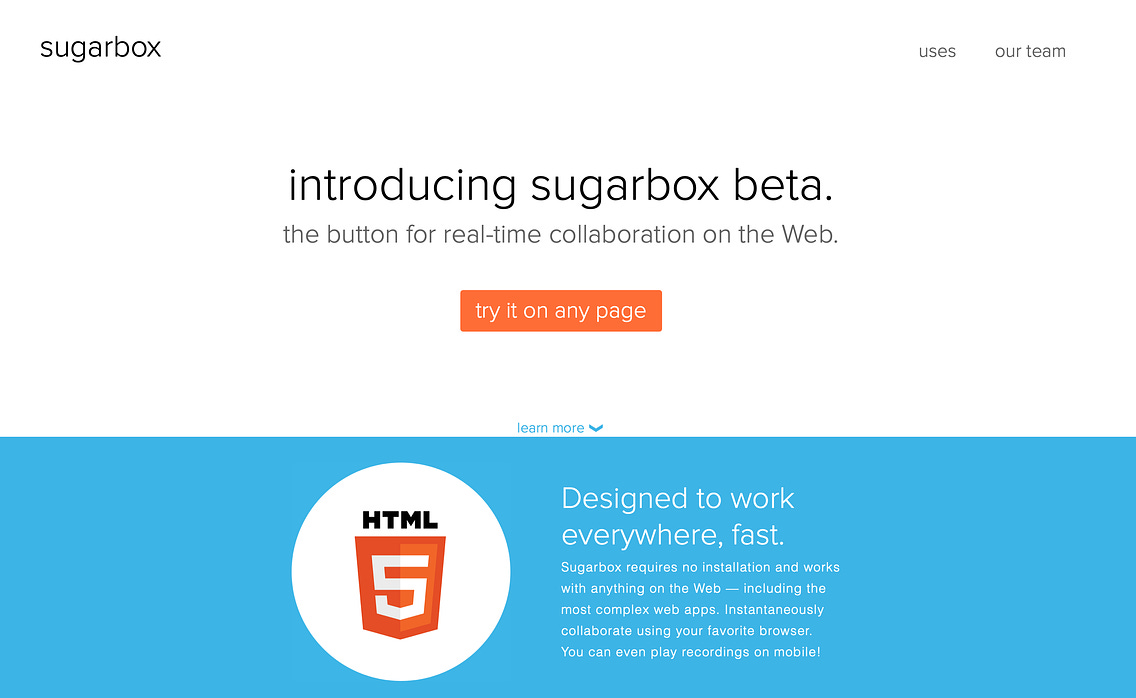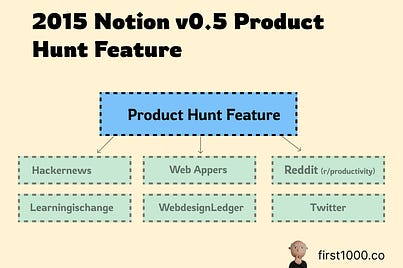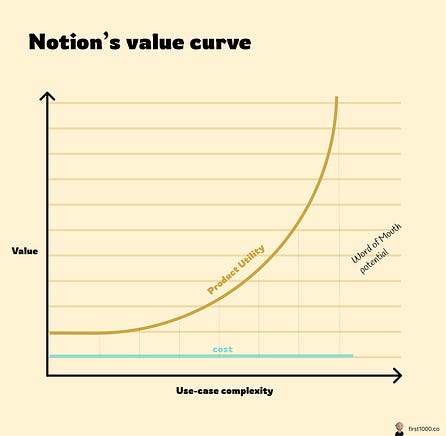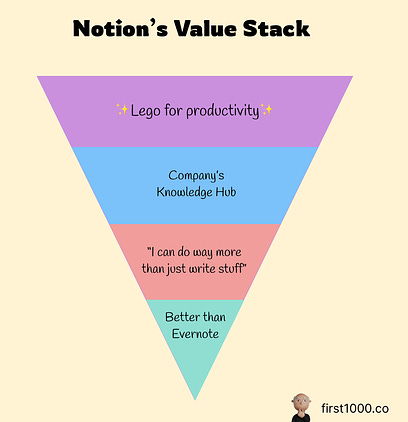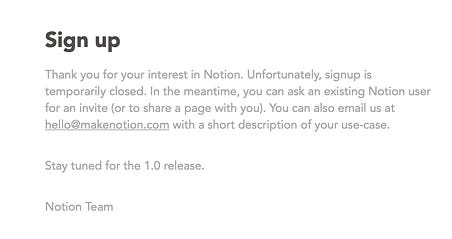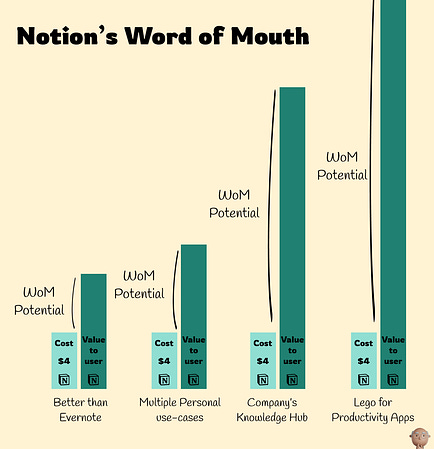First 1000 - ✨Notion
If this was forwarded your way and you wish to sign up to First 1000, you can do so here :) ✨Notion+ launching a product in a crowded space, growing through Word of Mouth and positioning a product that is hard to explain!
Today’s issue is brought to you by Masterworks. Starting a successful business is challenging. Roughly 90% of startups fail to ever earn a profit. That’s why I was amazed when I discovered Masterworks, the art investment platform. Scott Lynn founded Masterworks because he wanted to give everyday investors access to art investments, just like mega-billionaires. It turns out A LOT of people want to invest in art. In under four years, Masterworks went from 0 users to almost 300,000 and secured a valuation at over $1 billion. Art has been a solid investment historically. For example, a Basquiat painting was purchased for $20,000 and eventually resold for $110,000,000. What’s more, Blue-Chip Art prices outpaced the S&P 500 from 1995–2020. Numbers like this explain why many billionaires allocate 10-30% of their portfolios to art. But unless you have $100 million, you could never build a diversified art portfolio. This is where Masterworks comes in, where you can invest in paintings by legends like Warhol, Banksy, and Picasso at a price point you can afford. I love what Masterworks is doing for investors, so I decided to partner with them. Hello Frens 👋, Happy Tuesday! The holiday seasons are almost here and I’m getting in the spirits. Here is a little bit of Jimmy Fallon, a little bit of Ariana Grande, and a little bit of Megan Thee Stallion to bless your holidays!  Before we get to today’s company Notion, I have some exciting news to share. but Out there in the world, exists a First 1000 users interactive guide built on top Coda (Notion + Airtable hybrid on steroids). With that out of the way! Let’s jump right into Notion! — Notion’s Origin StoryMore than a decade ago, in 2011, a young artist Ivan Zhao graduated from one of the top Canadian universities: the University of British Columbia. As a self-taught programmer from a young age, Ivan opted not to get a formal education in programming, choosing to study cognitive science (with a minor in photography) instead. During those university years, Ivan fluctuated between pursuing a career in academia as a cognitive scientist and one in art photography; wherever Ivan went, so did his Contax T2 camera. He was a creative at heart. but soon after graduating, Ivan found himself on a 1-page portfolio websites creation spree. Being the only geek in a circle of fashion designers, artists, and creators, he was expected to put his technical talent in the group's service.
Ivan quit his job at the digital publishing company, Inkling, and teamed up with Toby Schachman to pursue this mission. Toby, at the time, had just finished his Master’s at NYU, where he published his entire thesis on visual programming. Visual programming was an elegant solution to the portfolio-creation problem Ivan was so keen on solving. But Ivan and Toby set their eyes on a much more ambitious project! Why stop at building a webpage builder? Why not make a tool to create any generic web app that people can use without learning how to code? In 2013, they raised some Seed money and were onto the races. Along the journey, they added one more person to the team: Simon Last. The two met up, and after a two-hour conversation, Toby convinced Simon to quit his summer internship and join Ivan and himself on their mission to democratize programming for everyone. The trio set out to build the first experiment to validate the hypothesis of creating a plug-and-play tool to create software. One of the first prototypes they built was Concept. Concept made it easy for people to collaborate live on building web pages. 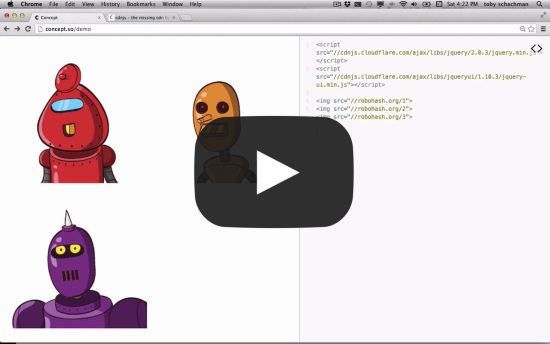
The team was Chris Prucha and Jessica Lam the creators behind SugarBox. Chris & Jessica met at Apple. The two quit their cushy jobs to build a dead-simple SDK that can turn any website into a collaborative one with one line of code.
The work on Notion started in late 2013/early 2014. But, by early 2015 the project was still held at a standstill. The app was constantly crashing, the real-time collaboration did not work as intended, and the team faced a critical decision. Either start the project from scratch on a new technical foundation or call it quits. To add salt to injury, the small angel round they had raised two years prior was not going to get them there no matter how far they stretch it! The company was on the verge of bankruptcy with nothing to show for all the teams hard work. Simon & Ivan made the hard decision to part ways with Chris & Jessica. The duo then moved to Kyoto, Japan, to rebuild the entire application from the ground up. The move to Japan + slimming down the team gave them some runway to give Notion a fighting chance to make it out into the real world. They sublet their San Francisco apartment and lived off the difference between SF & Kyoto rental costs. Being in a new country— where they did not speak the language and did not know anyone— meant Simon and Ivan could spend all their time programming, designing, thinking, and creating Notion. In March 2016, almost a year after they hit the reset button on building Notion, Ivan & Simon launched the product on Product Hunt. The launch ended up being to be one most successful ones in 2016! Thousands of people flocked to the Notion website to sign up and try this new product. The momentum from the launch helped Simon and Ivan raise a small bridge room that gave them some breathing room to build what is now a $10b enterprise! Let’s start with why- rationally it wouldn’t be. Selling a "hard to get" product.
The first problem a product like Notion has to overcome is explaining exactly what this tool does! Notion's power is derived from its flexibility & adaptability; instead of adjusting your workflow to fit Notion, Notion molds its software to accommodate you & your team. That very same power makes Notion exceedingly challenging to communicate to potential customers. One just “has to try it to get it.” Notion is not the first company to face this problem. Many have attempted to bundle different factures productivity software under one overarching umbrella. What Notion did differently from its predecessors, however, was to bundle single-player productivity with multiplayer productivity apps. Let’s take a closer look at different productivity bundling solutions at the time:
Notion’s wide-reaching bundle was possible because the product's core was differentiated. The two core product differentiations are:
These features help make explain why Notion chose Word + Confluence + Trello bundle for their 1.0. This bundle strikes a balance between having a low barrier to enter "low switching cost" for Docs, having a high utility on single+multiplayer (all three), and highlighting the product block-mixing power (differentiation). On the other hand, Quip, Amuim, Bear, et al. were forced to make a different set of choices. The core value proposition for these bundling solutions was layering in an additional productivity functionality on top of a familiar one. Hence, they had to go all-in Multiplayer utility (e.g., combining chat with file sharing is only useful when you have a meaningful number of team members using said software), making it harder to gain mindshare or go all-in on single-player utility, making it harder to monetize. Go To Market Strategy99% of the growth of Notion is Word of Mouth (WoM) driven. Whenever I hear WoM, I think of it as an obscure catch-all phrase that makes a company more appealing to investors. But in researching this piece, I wanted to understand how exactly Notion grew through Word of mouth? Especially when they didn’t have an established customer base or a following to lean on to kickstart the process. It came down to a simple two-step process:
This may sound like a vanilla-abstract strategy, but it isn't.
Moving people along the value curve:There are infinite possibilities and use cases for Notion; this is the power of being a malleable software. However, for the sake of this research, I bundled them into four levels.
A simplistic yet fun way to think of team-based software as a game. The winner of the game is the person that convinces everyone on their team to play their personal favorite game. From a company's perspective, in our case, Notion, we established that the goal is to get as many users to the highest-value level ASAP. By doing so, the user would have invested just enough into being a master of this game that they would be a lot more likely to recruit their colleagues to play alongside them rather than attempt to master a whole new game themselves! But Notion, like any new company getting started, didn't have a magical cohort of people who mastered their software and the block-first architecture. What they had, was a good product sense that maximized the number of people who reached the highest level of the Notion Value Stack. Let's take a look into what they did there: Getting users to Level 1 Everything pre-sign-up on Notion is focused on teaching people how to use the product. The end-state is left for the users to imagine. While other more-established productivity software focused exclusively on what to use their product for (i.e., the value proposition of said software). Once you know how to use Notion, it can be whatever you want it to be. It could be a Wiki, a knowledge hub, a task management tool, a to-do list, and the landing page is optimized to get you to think about what that ideal use-case would be for you by showing you the power of the tool! Getting users to Level 2 After showing "what they can do." It was time to put some of that learning into action. If Notion's Landing page was about the what, the onboarding process was about the how. Onboarding on Notion was all about showing users how they could use the product. I could not access the early tutorial, but here are a few samples of early feedback on the onboarding process that reflects just how much effort they put into training people to be Notion Jedis.
Getting users to Level 3 & Level 4 To get people towards the highest level of the value stack, moving from the personal use-case to the multiplayer one, Notion did a few things. Second was showcasing the power of Notion in a company setting. Releasing Notion’s Product roadmap (built on Notion, of course) was how they did that. The open-sourced roadmap showed "Notion in action" on an enterprise level and highlighted all the new team collaboration features that were just on the horizon. (If a particular feature was what was holding you back, seeing it is one, two, three weeks away gave people the confidence to adapt Notion for their teams now, knowing they’ll soon be (very well) served.) The third thing was templates. The Notion v1.0 came with 30 templates team-ready templates that ranged from a design spec template to a knowledge hub one. — When looking at all these things they did to move people along the value stack, a couple of things stand out. The first is how Notion's journey starts with a very simple value-proposition that solves users' immediate problems, then guides people towards "unlocking" more valuable use-cases. The second is their pricing. Notion is priced off the minimum value the software can deliver. At $8 (later $4 and now free) for personal use, Notion was on par with Evernote, a personal note-taking app. But Notion blows Evernote out of the water on Note-taking alone and is much more powerful & versatile than just a note-taking app. If the average company replaced 5-6 tools by adapting Notion (that is just my very uneducated guess), then pricing it at $20-$30 would still be a bargain for any enterprise. Yet, with aggressive under-pricing, all the surplus value that users unlock as they build more powerful use-cases feeds directly the company's growth potential through WoM rather than their top line. Notion's under-pricing, even their lowest-value competitor, makes it almost criminal not to adapt Notion and spread it into the workspace. Imagine working at a small startup that is stitching together Jira, Google Docs & Confluence. They spend $45 / user. With the switch to Notion, they spent $4/user and have all their data consolidated in one place. If no one got fired for buying IBM, then surely no one will get fired for buying Notion and dropping the company's productivity stack costs by 90%+. The more Notion widened the gap between cost & value, the more invested users became in the product and, in turn, recruited friends, colleagues, and collaborators onto the product. And this is how the company grew like wildfire through "word of mouth.” Some Learnings from writing this piece
First 1000 benefit of the week:
I teamed up with the team @ Coda to offer $1000 credit on any paid Coda plan for your startup. Go to this link, click on ‘Apply for startup credit’ and put ‘First1000’ for the ‘Program involvement’ question." I'm working on revamping the First 1000 website & the referral program, and it should be ready by the beginning of 2022. A sad true story is that I measure my self-worth in how many new subscribers each piece gets. Make me feel good about myself this week :( See you next week 😉, *See important disclosures If you liked this post from First 1000, why not share it? |
Older messages
Navigating First 1000
Tuesday, December 7, 2021
Making the best out of all previous First 1000 issues.
53 ideas to get your first customers.
Tuesday, November 30, 2021
Today's issue is brought to you by Alternative Assets: There are tons of stock market newsletters. The Alternative Assets Newsletter is about stuff that doesn't get discussed as much. Each week
🕵️ Getting your first 1000 customers through SEO
Tuesday, November 23, 2021
Step by step guide to acquiring your first users through SEO.
✍️ Substack
Tuesday, November 16, 2021
and the power of trust.
✍️ Newcomer
Monday, November 1, 2021
and getting your first 1000 true fans
You Might Also Like
🚀 Ready to scale? Apply now for the TinySeed SaaS Accelerator
Friday, February 14, 2025
What could $120K+ in funding do for your business?
📂 How to find a technical cofounder
Friday, February 14, 2025
If you're a marketer looking to become a founder, this newsletter is for you. Starting a startup alone is hard. Very hard. Even as someone who learned to code, I still believe that the
AI Impact Curves
Friday, February 14, 2025
Tomasz Tunguz Venture Capitalist If you were forwarded this newsletter, and you'd like to receive it in the future, subscribe here. AI Impact Curves What is the impact of AI across different
15 Silicon Valley Startups Raised $302 Million - Week of February 10, 2025
Friday, February 14, 2025
💕 AI's Power Couple 💰 How Stablecoins Could Drive the Dollar 🚚 USPS Halts China Inbound Packages for 12 Hours 💲 No One Knows How to Price AI Tools 💰 Blackrock & G42 on Financing AI
The Rewrite and Hybrid Favoritism 🤫
Friday, February 14, 2025
Dogs, Yay. Humans, Nay͏ ͏ ͏ ͏ ͏ ͏ ͏ ͏ ͏ ͏ ͏ ͏ ͏ ͏ ͏ ͏ ͏ ͏ ͏ ͏ ͏ ͏ ͏ ͏ ͏ ͏ ͏ ͏ ͏ ͏ ͏ ͏ ͏ ͏ ͏ ͏ ͏ ͏ ͏ ͏ ͏ ͏ ͏ ͏ ͏ ͏ ͏ ͏ ͏ ͏ ͏ ͏ ͏ ͏ ͏ ͏ ͏ ͏ ͏ ͏
🦄 AI product creation marketplace
Friday, February 14, 2025
Arcade is an AI-powered platform and marketplace that lets you design and create custom products, like jewelry.
Crazy week
Friday, February 14, 2025
Crazy week. ͏ ͏ ͏ ͏ ͏ ͏ ͏ ͏ ͏ ͏ ͏ ͏ ͏ ͏ ͏ ͏ ͏ ͏ ͏ ͏ ͏ ͏ ͏ ͏ ͏ ͏ ͏ ͏ ͏ ͏ ͏ ͏ ͏ ͏ ͏ ͏ ͏ ͏ ͏ ͏ ͏ ͏ ͏ ͏ ͏ ͏ ͏ ͏ ͏ ͏ ͏ ͏ ͏ ͏ ͏ ͏ ͏ ͏ ͏ ͏ ͏ ͏ ͏ ͏ ͏ ͏ ͏ ͏ ͏ ͏ ͏ ͏ ͏ ͏ ͏ ͏ ͏ ͏ ͏ ͏ ͏ ͏ ͏ ͏ ͏ ͏ ͏ ͏ ͏ ͏ ͏ ͏ ͏ ͏ ͏
join me: 6 trends shaping the AI landscape in 2025
Friday, February 14, 2025
this is tomorrow Hi there, Isabelle here, Senior Editor & Analyst at CB Insights. Tomorrow, I'll be breaking down the biggest shifts in AI – from the M&A surge to the deals fueling the
Six Startups to Watch
Friday, February 14, 2025
AI wrappers, DNA sequencing, fintech super-apps, and more. ͏ ͏ ͏ ͏ ͏ ͏ ͏ ͏ ͏ ͏ ͏ ͏ ͏ ͏ ͏ ͏ ͏ ͏ ͏ ͏ ͏ ͏ ͏ ͏ ͏ ͏ ͏ ͏ ͏ ͏ ͏ ͏ ͏ ͏ ͏ ͏ ͏ ͏ ͏ ͏ ͏ ͏ ͏ ͏ ͏ ͏ ͏ ͏ ͏ ͏ ͏ ͏ ͏ ͏ ͏ ͏ ͏ ͏ ͏ ͏ ͏ ͏ ͏ ͏ ͏ ͏ ͏ ͏ ͏ ͏ ͏
How Will AI-Native Games Work? Well, Now We Know.
Friday, February 14, 2025
A Deep Dive Into Simcluster ͏ ͏ ͏ ͏ ͏ ͏ ͏ ͏ ͏ ͏ ͏ ͏ ͏ ͏ ͏ ͏ ͏ ͏ ͏ ͏ ͏ ͏ ͏ ͏ ͏ ͏ ͏ ͏ ͏ ͏ ͏ ͏ ͏ ͏ ͏ ͏ ͏ ͏ ͏ ͏ ͏ ͏ ͏ ͏ ͏ ͏ ͏ ͏ ͏ ͏ ͏ ͏ ͏ ͏ ͏ ͏ ͏ ͏ ͏ ͏ ͏ ͏ ͏ ͏ ͏ ͏ ͏ ͏ ͏ ͏ ͏ ͏ ͏ ͏ ͏ ͏ ͏ ͏ ͏ ͏ ͏ ͏ ͏ ͏ ͏ ͏ ͏

